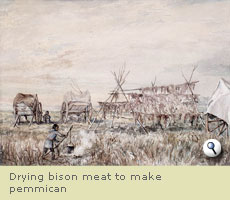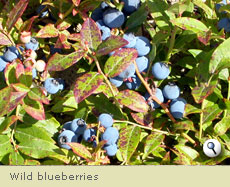Food was the voyageur's fuel, giving him energy to paddle long hours and cover great distances. In a world of gruelling work and scarcity, food was the top concern.

|
Hunt, fish and forage
Feed the voyageur without upsetting his stomach! |
Jargon of the voyageur era illustrates just how important food was for them. Voyageurs plying the routes from Montreal to Fort William and Rainy Lake bore the nickname mangeurs de lard, after their diet consisting mainly of salt pork and pork fat. The men of the Hudson's Bay Company, being mostly from the British Isles, were dubbed Oatmeal Eaters, due to their preference for this cereal.
Food stocks voyageurs took with them needed to be compact, lightweight, calorie-rich and long-lasting. Easily transportable dry goods were most practical. Cornmeal, wild rice, meat and maple sugar were dehydrated, packaged and sealed to increase their shelf life. On the water, the men often had to eat fast without stopping. "Corn and grease", a porridge-like mixture of corn and animal fat, was an important part of their diet. Pemmican consists of shredded dried meat blended with fat and berries, and was a vital foodstuff in the North West.


The voyageur diet varied from one region to another. Trading posts obtained provisions from First Nations, who supplied them with wild rice, game and pemmican. In the interior, diets were usually protein-based. Fish was a common staple in many areas, and was especially important in winter. Wintering posts also provided the men with locally available and less transportable items, including fresh meat, maple sugar and vegetables that they grew in small gardens.
The voyageurs sometimes suffered food shortages over the winter months. In these times, rations were reduced and they turned to subsistence food. They survived on wild vegetables, tree bark and lichen such as tripe de roche (rock tripe), which was actually more nutritious than corn! As a last resort, voyageurs facing starvation even sustained themselves on rotten fish.
Cost, calorie count, weight and shelf life were more important for the Company than nutritional value. As a result, the men ate large quantities of meat and fat. Diseases related to vitamin deficiencies, such as scurvy, sometimes occurred when food sources failed.
Along with alcohol and tobacco, food accompanied many important events in the voyageur's life. From religious celebrations to rites of passage, eating confirmed his unique place in this world.
| Previous | Top of page | Next |